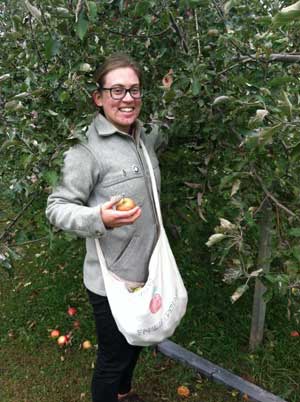Vermont fruit and vegetable farmers produce hundreds of tons of edible, farm-fresh food, but often, not all of their production is sold. These leftover products are sometimes wasted, but through gleaning, they can be put to good use.
 Marcella Houghton, AmeriCorps VISTA, gleans apples at Yates Family Orchard in Hinesburg
Marcella Houghton, AmeriCorps VISTA, gleans apples at Yates Family Orchard in HinesburgGleaning is the process of salvaging those leftover or damaged crops, and in Vermont, the food that is gleaned by organizations such as Salvation Farms is then redistributed to those in need. A new online tool created by Salvation Farms, with support from the Vermont Digital Economy Project as well as others including the Lamoille Economic Development Corporation and the Harris and Frances Block Foundation, hopes to make this process easier. Using the new website, volunteers to can register to be notified of gleaning opportunities in their area.
For nearly ten years, Morrisville-based Salvation Farms has been helping Vermont communities establish effective gleaning programs. The organization has now connected gleaners around the state into the Vermont Gleaning Collective. The Collective and the new online tool are designed to facilitate increasingly efficient community-based efforts. Recruiting volunteers to “glean” the fields and coordinating efforts with farm owners has always been a hindrance to reducing food waste. The new website, known as the Gleaning Interface, makes it easier for members of the Vermont Gleaning Collective to recruit, register, and coordinate volunteers, and to track all hours contributed and every pound that member organizations capture and distribute statewide.
This is exactly the type of project the Digital Economy Project is proud to support. The Gleaning Interface uses online tools to make an age old process more efficient and effective. Gleaning reduces waste and makes better use of the resources consumed to grow food, and allows people in need of healthy food to provide it for themselves at no monetary cost while simultaneously supporting others in their community. It makes our region as a whole more food independent.
Organizations involved in the Gleaners Collective include Community Harvest of Central Vermont, Helping Overcome Poverty’s Effects (HOPE) and, the Intervale Center.
“The Gleaners Interface will decrease the time needed to complete administrative tasks, allowing us to focus our time on being in the fields recovering surplus food produced on farms all around the Rutland region. We can then give the produce to those in our community that have limited access to healthy local fresh food,” said Tara Kelly, director of Rutland Area Farm and Food Link (RAFFL),“Please register to come join us in the fields and help all of our neighbors eat locally.”
Salvation Farms director Theresa Snow is incredibly excited for the tool web-based tool. “This has been an incredible process, to have a vision for a highly integrated online tool to support and connect gleaning across Vermont and watch it become a reality. It is truly remarkable. We are so thankful to the Vermont Digital Economy Project for their investment in this online platform, a tool that is bound to move the professionalism and existence of gleaning in Vermont to the next level.”
To become a gleaner visit www.salvationfarms.org and click on “Become a Gleaner Today” or visit http://vermontgleaningcollective.org/
